Experimental Study on Factors Affecting the Performance of Foamy Oil Recovery
Abstract
:1. Introduction
2. Experiment
2.1. Experimental Equipment
2.2. Experimental Fluids
2.3. Experimental Procedure
- First, the dry sand-filled sandpack was CT scanned to obtain the dry model and check if the sandpack was packed uniformly.
- Then, the white oil was pumped into the sandpack to pre-saturate the sandpack, which would make the crude oil saturation process more complete.
- The live oil was injected from a mixing cell to prevent gas segregation.
- After the sandpack was saturated by live oil at reservoir pressure and temperature, the inlet valve was closed.
- The fluid was produced from the outlet, which was controlled by a relief valve.
- The pressure was recorded by the piezometers among the sandpack.
- The sandpack was scanned every 10 min to achieve the real-time monitoring of the heavy oil depletion process.
- Every single experiment was ended when the system pressure reached atmosphere and no more liquid was produced.
2.4. Experimental Conditions
3. Results and Discussion
3.1. Effect of the Depletion Scenario in Foamy Oil Flow Behavior
3.2. Effect of the Depletion Rate on the Linear Pressure Drop Process
3.3. Effect of the Temperature on the Linear Pressure Drop Depletion
3.4. Natural Gas Huff-n-Puff Process
3.5. Effect of the Sandpack Permeability on the Linear Depletion Process
4. Conclusions
- (1)
- Although the oil recovery factor of the linear pressure drop mode was similar to that of the step-down mode, the displacement mechanism was different between those two models. The oil saturation reduced uniformly among the entire sandpack for the step-down model; however, the linear model could produce more oil at the outlet region.
- (2)
- Increasing the rate of the linear mode was beneficial to oil recovery, because the lack of time prevented bubbles from gas channeling.
- (3)
- Under a constant gas–oil ratio, increasing the reservoir temperature had a favorable effect on the recovery efficiency and had a greater impact on the production curve.
- (4)
- In a depleted experiment, the remaining oil was mainly concentrated in the inlet section, and the outlet end had a higher degree of recovery. The gas huff-n-puff process had almost no effect on the outlet side where the gas channel was formed, but it could be employed to mobilize the remaining oil around the inlet area.
- (5)
- For the sandpack with a higher permeability, there was more residual oil at the outlet. The reason for this is that oil migration in the front is required to pass through the end, so that the outlet maintains a long period of high oil content. The longer time lasts, the more dissolved gas forms. Subsequently, the outlet accumulates a certain amount of degassed crude oil, which is difficult to drive out.
Author Contributions
Funding
Conflicts of Interest
References
- Smith, G.E. Fluid Flow and Sand Production in Heavy-Oil Reservoirs Under Solution-Gas Drive. SPE Prod. Eng. 1988, 3, 169–180. [Google Scholar] [CrossRef]
- Sarma, H.; Maini, B.B. Role of Solution Gas in Primary Production of Heavy Oils. In Proceedings of the Latin America Petroleum Engineering Conference, Caracas, Venezuela, 8–11 March 1992. [Google Scholar]
- Bora, R. Cold Production of Heavy Oils: An Experimental Investigation of Foamy Oil Flow in Porous Media. Ph.D. Thesis, University of Calgary, Calgary, AB, Canada, 1998. [Google Scholar]
- Busahmin, B.; Maini, B. Effect of Solution-Gas-Oil-Ratio on Performance of Solution Gas Drive in Foamy Heavy Oil Systems. In Proceedings of the Canadian Unconventional Resources and International Petroleum Conference, Calgary, AB, Canada, 19–21 October 2010. [Google Scholar]
- Mohammed, S.; Amarfio, E.; Dankwa, O. Production Analysis for Solution Gas-Drive Reservoirs: General Variable Pressure/Variable Rate Case-Theory. In Proceedings of the SPE Nigeria Annual International Conference and Exhibition, Lagos, Nigeria, 5–7 August 2014. [Google Scholar]
- Francisco, A.; Tayfun, B. Analytical Solutions and Derivation of Relative Permeabilities for Water-Heavy Oil Displacement and Gas-Heavy Oil Gravity Drainage Under Non-Isothermal Conditions. SPE Reserv. Eval. Eng. 2016, 19, 181–191. [Google Scholar]
- Egermann, P.; Vizika, O. Critical Gas Saturation and Relative Permeability during Depressurization the Far Field and the Near-Wellbore Region. In Proceedings of the SPE Annual Technical Conference, Dallas, TX, USA, 1–3 October 2000. [Google Scholar]
- Dusseault, M.B.; Rothernburg, L. Shear dilatancy and permeability enhancement in oil sands. In Proceedings of the 4th UNITAR/UNDP Conference on Heavy Crude and Tar Sands, Edmonton, AB, Canada, 7–12 August 1988; pp. 7–12. [Google Scholar]
- Baibakovn, N.K.; Garushev, A.R. Thermal Methods of Petroleum Production; Elsevier Science Publishers: Amsterdam, The Netherlands, 1989; pp. 6–21. [Google Scholar]
- Firoozabadi, A.; Ottesen, B.; Mikkelson, M. Measurements of supersaturation and critical gas saturation. SPE Form. Eval. 1992, 7, 337–343. [Google Scholar] [CrossRef]
- Kraus, W.P.; McCaffrey, W.J.; Boyd, G.W. Pseudo-bubble point model for foamy oil. In Proceedings of the 44th Annual Technology Conference Petroleum Society of CIM, Calgary, AB, Canada, 9–12 May 1993. [Google Scholar]
- Sheng, J.J.; Maini, B.B.; Hayes, R.E.; Tortike, W.S. Critical Review of Foamy Oil Flow. Transp. Porous Media 1999, 35, 157–187. [Google Scholar] [CrossRef]
- Maini, B.B. Effect of Depletion Rate on Performance of Solution Gas Drive in Heavy Oil System. In Proceedings of the Latin American and Caribbean Petroleum Engineering Conference, Port-of-Spain, Trinidad and Tobago, 27–30 April 2003. [Google Scholar]
- Ostos, A.; Maini, B.B. Capillary number in heavy oil solution gas drive and its relationship with gas-oil relative permeability curves. In Proceedings of the SPE/DOE Symposium on Improved Oil Recovery, Tulsa, Oklahoma, 17–21 April 2004. [Google Scholar]
- Stik, C.; Robertson, C.; Kalpakci, B.; Gupta, D. A Study of Heavy Oil Solution Gas Drive for Hamaca Field: Depletion Studies and Interpretations. In Proceedings of the SPE International Thermal Operations and Heavy Oil Symposium and Western Regional Meeting, Bakersfield, CA, USA, 16–18 March 2004. [Google Scholar]
- Claridge, E.L.; Prats, M. A Proposed Model and Mechanism for Anomalous Heavy Oil Behavior. In Proceedings of the International Heavy Oil Symposium, Calgary, AB, Canada, 19–21 June 1995. [Google Scholar]
- Alshmakhy, A.B.; Maini, B.B. Effect of Foaminess on the Performance of Solution Gas Drive in Heavy Oil Reservoirs. J. Can. Pet. Technol. 2009, 48, 36–41. [Google Scholar] [CrossRef]
- Sun, X.; Zhang, Y.; Cui, G.; Duan, X.; Zhao, C. Feasibility study of enhanced foamy oil recovery of the Orinoco Belt using Natural Gas. J. Pet. Sci. Eng. 2014, 122, 94–107. [Google Scholar] [CrossRef]
- Liu, P.C.; Li, W.H.; Hao, M.Q.; Wu, Y.B.; Li, X.L. Quantitative evaluation of factors affecting foamy oil recovery in the development of heavy hydrocarbon reservoirs. Int. J. Hydrogen Energy 2016, 41, 15624–15631. [Google Scholar] [CrossRef]
- Tang, G.; Firoozabadi, A. Effect of GOR, Temperature, and Initial Water Saturation on Solution-Gas Drive in Heavy-OIl Reservoirs. In Proceedings of the 2001 SPE Annual Technical Conference and Exhibition, New Orleans, LA, USA, 30 September–3 October 2001. [Google Scholar]
- Tang, G.Q.; Sahni, A.; Gadelle, F.; Kumar, M.; Kovscek, A.R. Heavy-Oil Solution Gas Drive in Consolidated and Unconsolidated Rock. In Proceedings of the International Thermal Operations and Heavy-Oil Symposium and Western Regional Meeting, Bakersfield, CA, USA, 16–18 March 2004. [Google Scholar]
- Liu, P.; Wu, Y.; Li, X. Experimental Study on the Stability of the Foamy Oil in Developing Heavy Oil Reservoirs. Fuel 2013, 111, 12–19. [Google Scholar] [CrossRef]
- Zhang, X.; Tahmasebi, P. Micromechanical evaluation of rock and fluid interactions. Int. J. Greenh. Gas Control 2018, 76, 226–277. [Google Scholar] [CrossRef]
- Fagbemi, S.; Tahmasebi, P.; Piri, M. Pore-scale modeling of multiphase flow through porous media under triaxial stress. Adv. Water Resour. 2018, 122, 206–216. [Google Scholar] [CrossRef]
- Moulu, J.C.; Longeron, D.L. Solution—Gas drive: Experiments and simulation. In Proceedings of the 5th European Symposium, Improved Oil Recovery, Budapest, Hungary, 25–27 April 1989; pp. 145–154. [Google Scholar]
- Wellington, S.L.; Vinegar, H.J. X-ray Computerized Tomography. J. Pet. Technol. 1987, 39, 885–898. [Google Scholar] [CrossRef]
- Kleinberg, R.; Vinegar, H. NMR Properties of Reservoir Fluids. J. Log Analy. 1996, 37, 238–252. [Google Scholar]
- Bryan, J.; Kantzas, A.; Bellehmeur, B. Oil Viscosity Predictions from Low Field NMR Measurements. J. SPE Reserv. Eval. Eng. 2005, 8, 44–52. [Google Scholar] [CrossRef]
- Lv, W.; Yang, J.; Jia, N. A Study of Gas Bubble Formation Mechanism During Foamy Oil Depletion Experiment. Spec. Top. Rev. Porous Media 2018, 9, 37–45. [Google Scholar] [CrossRef]
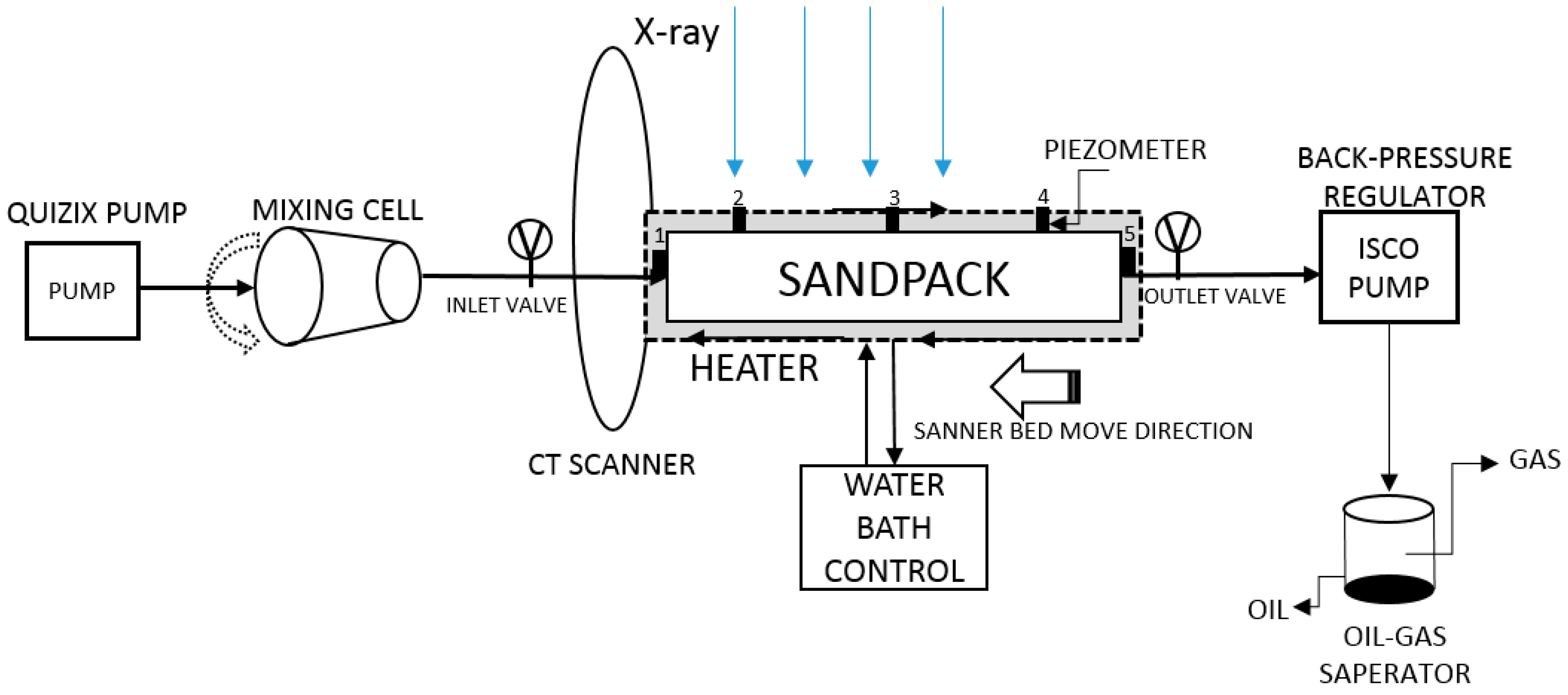




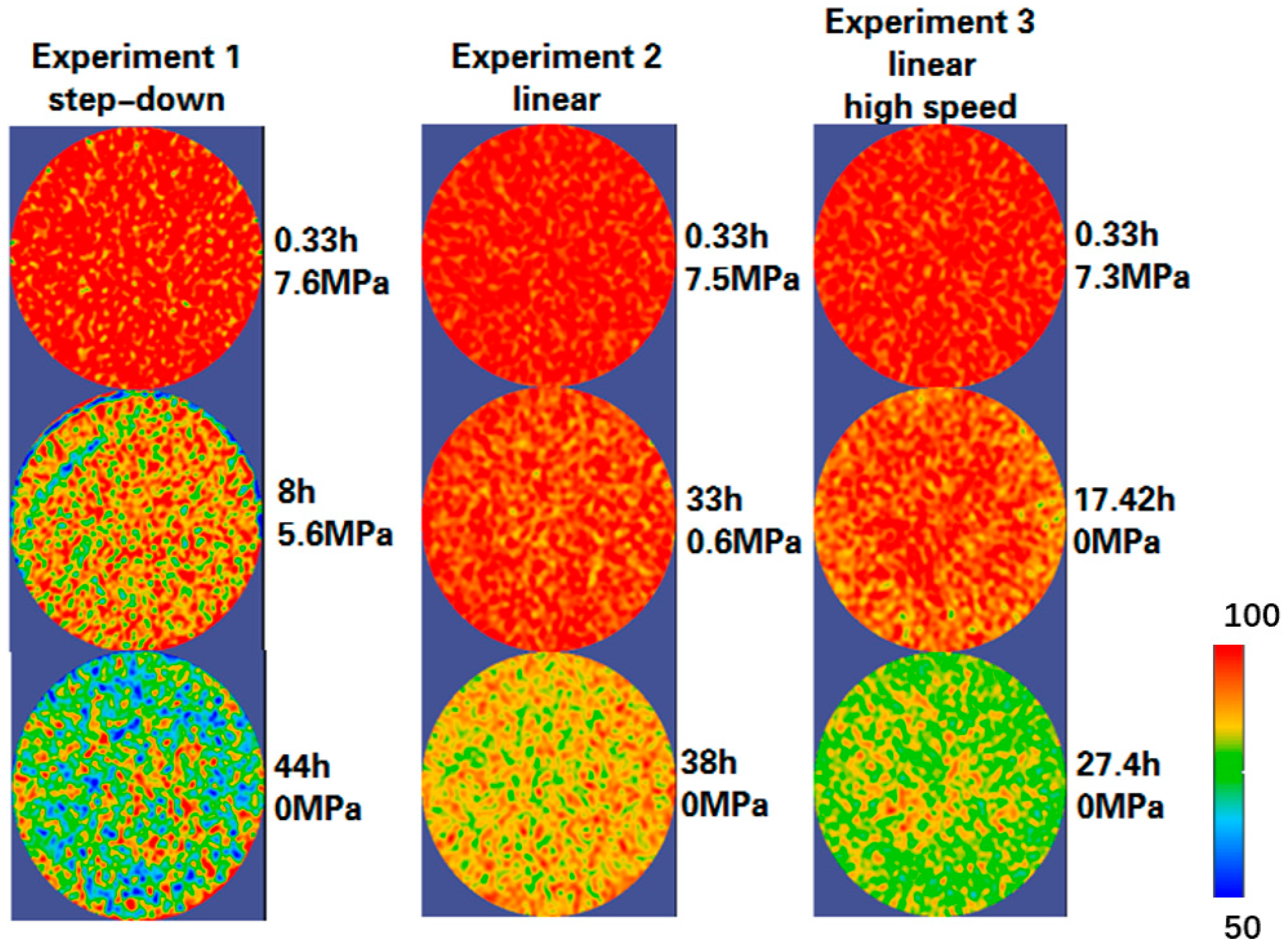
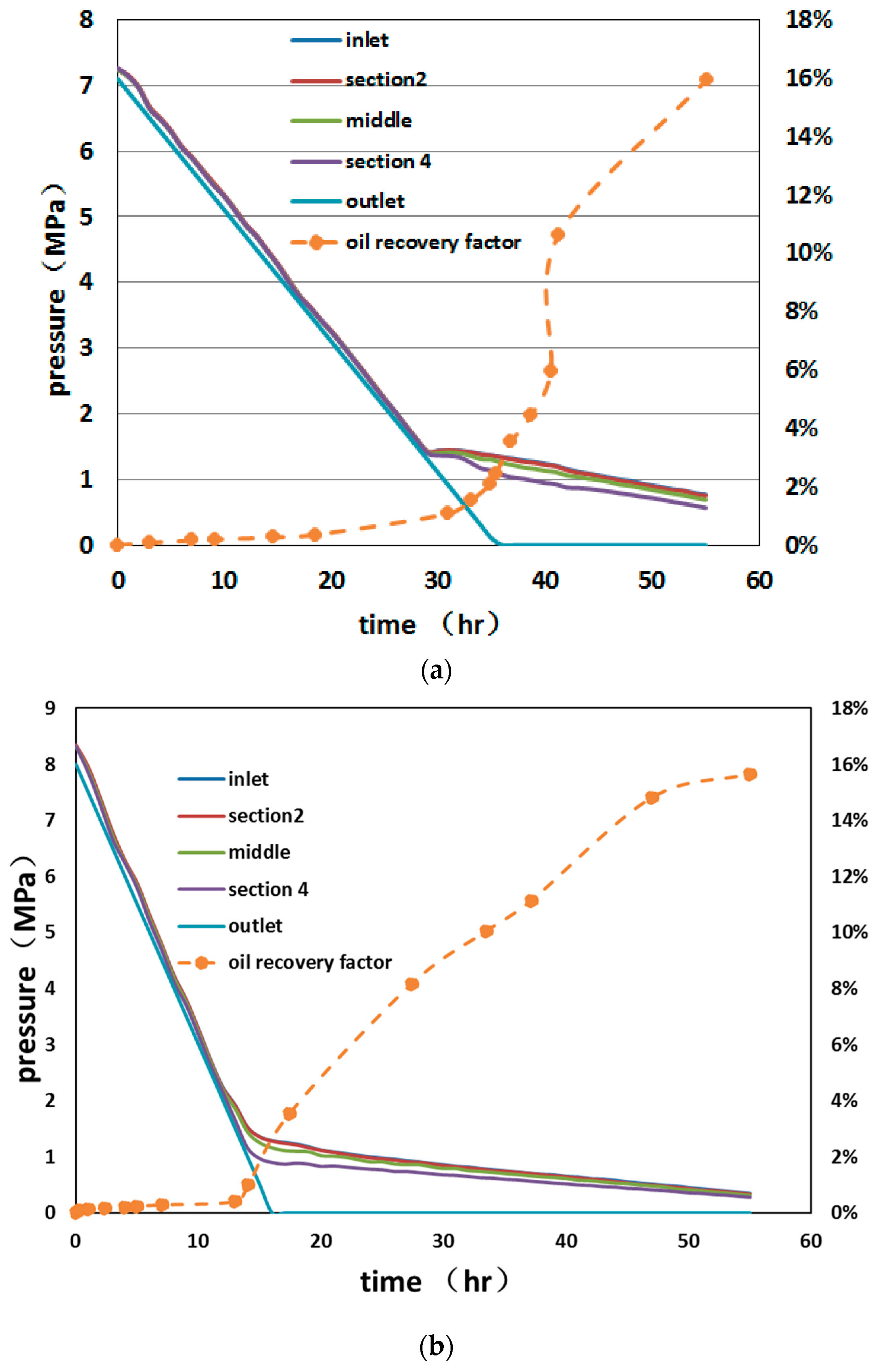
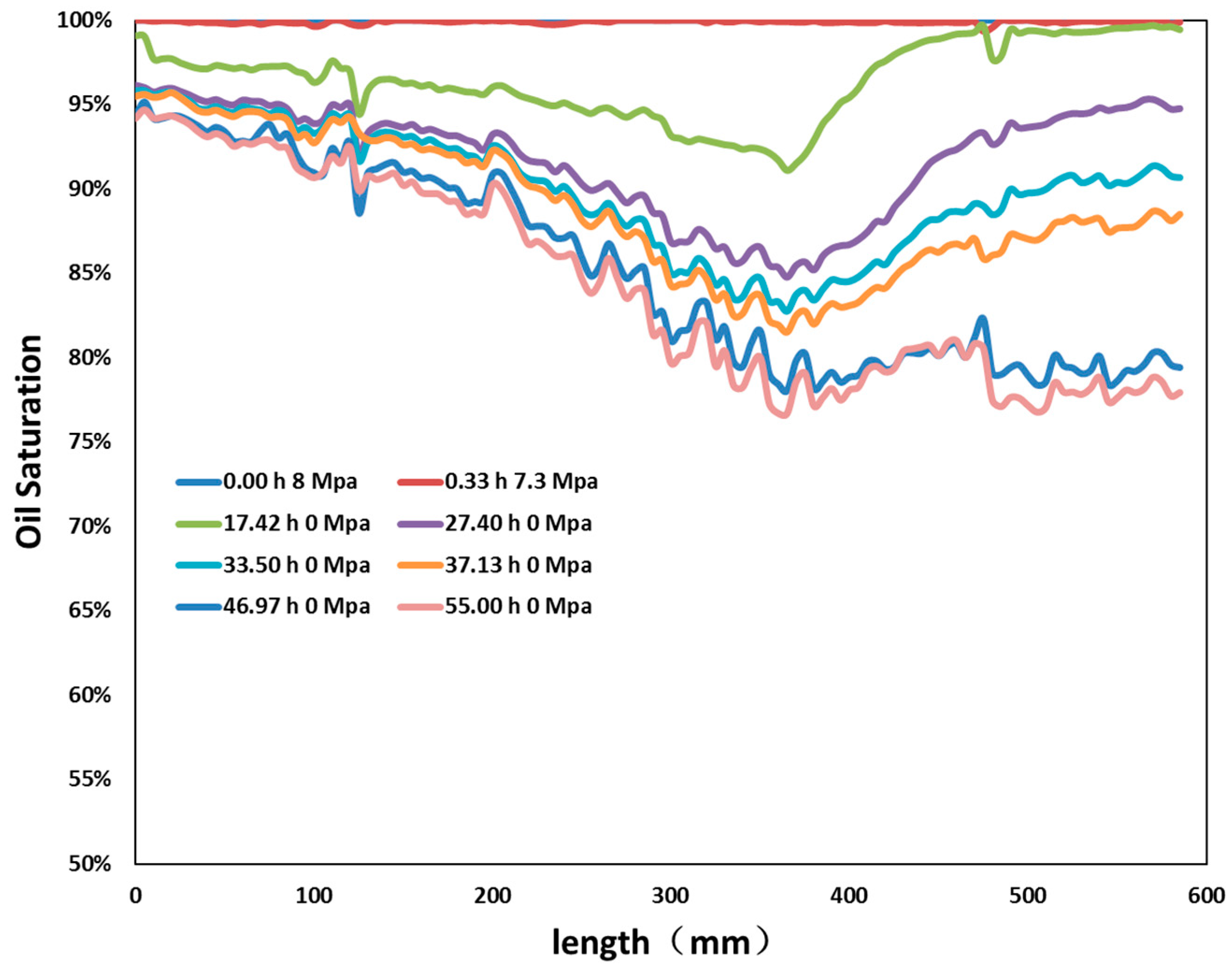
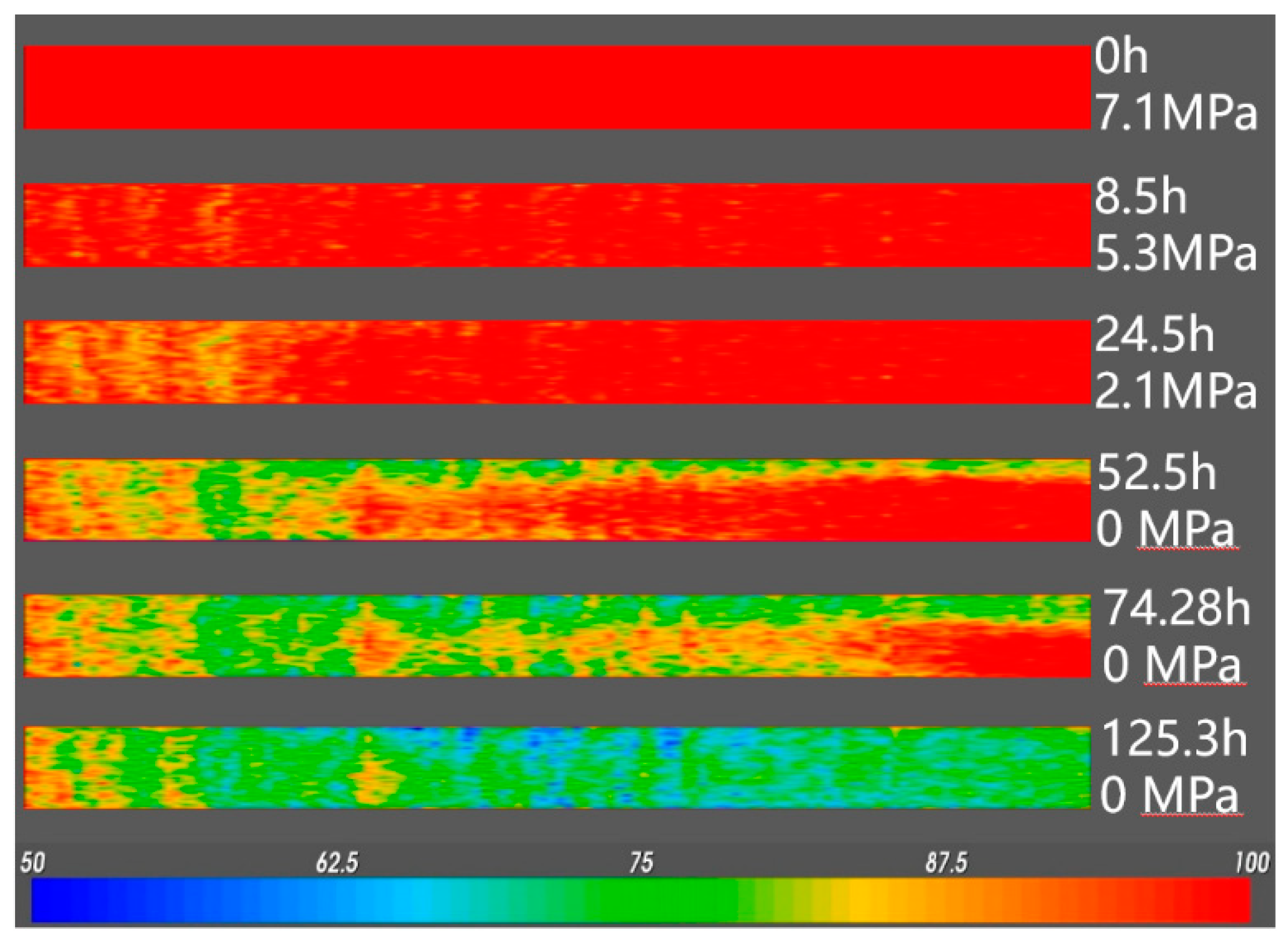

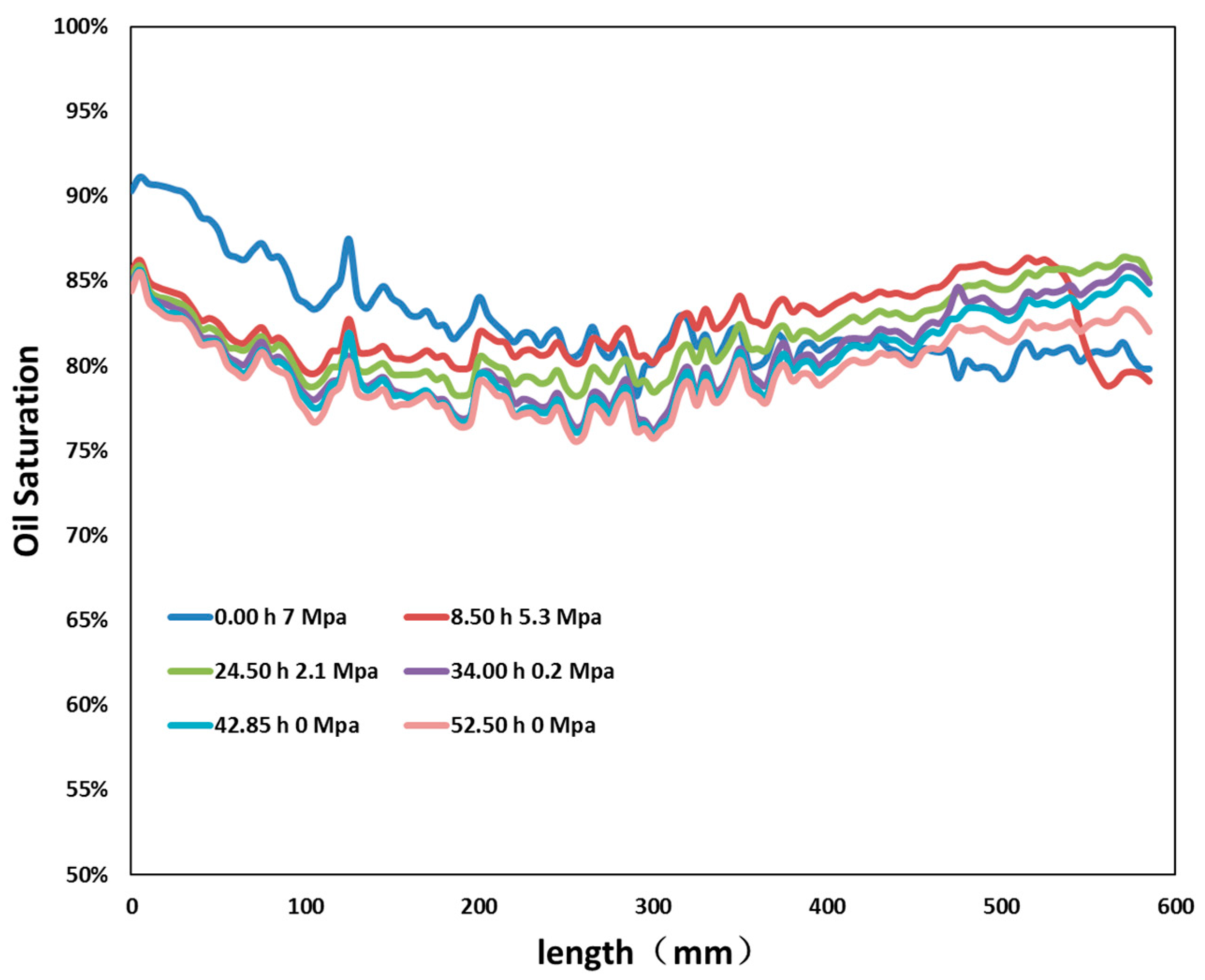

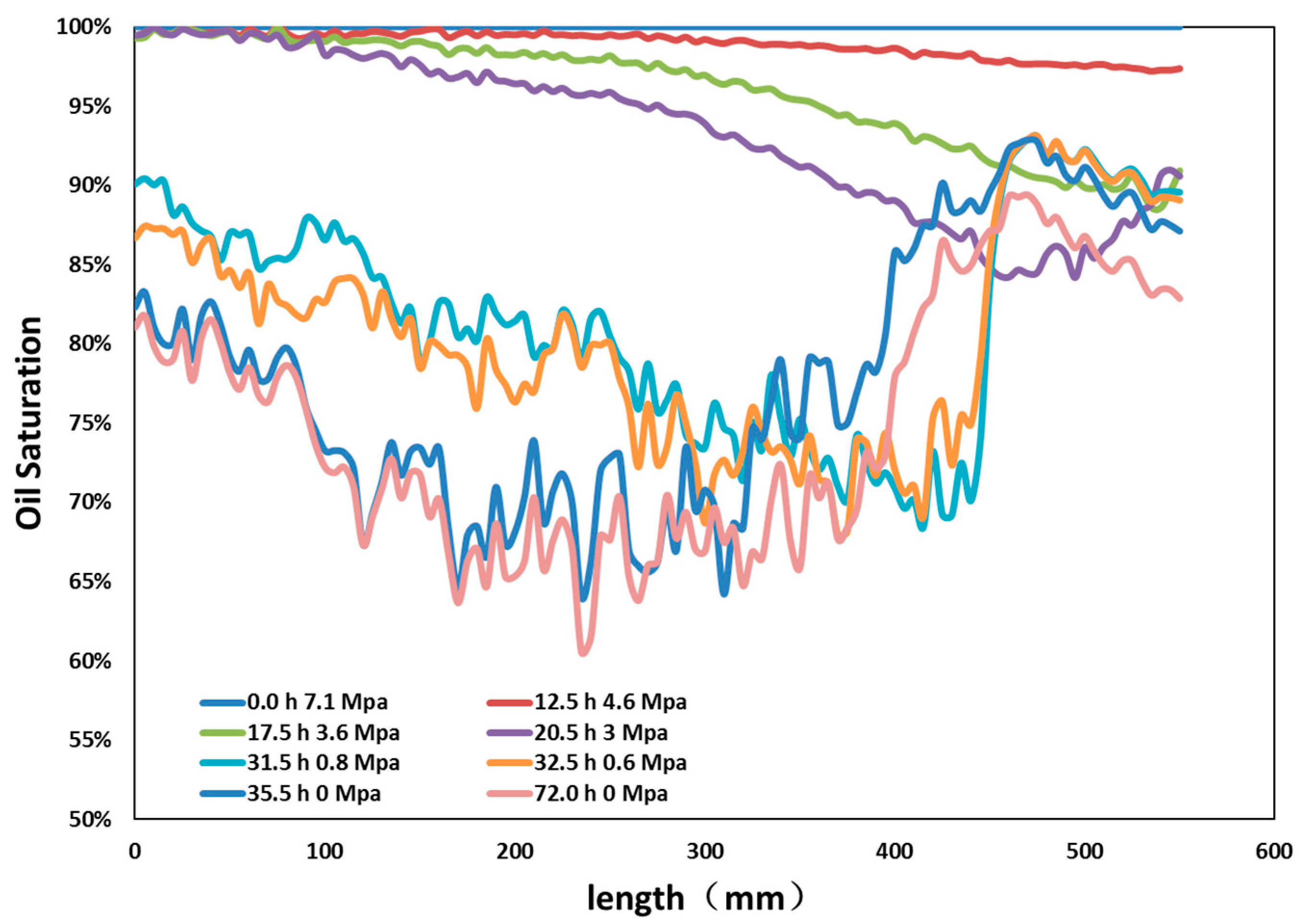
| Density | 0.975 g/cm3 |
| Viscosity under 80 °C | 8749 mPa.s |
| Bubble point pressure under 80 °C | 4.7 MPa |
| Gas–oil ratio | 18.0 m3/m3 |
| Experiments | Permeability (D) | Depletion Mode | Depletion Rate | Temperature (°C) |
|---|---|---|---|---|
| 1 | 8.1 | Step-down | 0.2 M/step | 60 |
| 2 | 7.6 | Linear | 0.2 MPa/h | 60 |
| 3 | 7.5 | Linear | 0.5 MPa/h | 60 |
| 4 | 8.2 | Linear | 0.2 MPa/h | 80 |
| 5 | 13.6 | Linear | 0.2 MPa/h | 60 |
© 2019 by the authors. Licensee MDPI, Basel, Switzerland. This article is an open access article distributed under the terms and conditions of the Creative Commons Attribution (CC BY) license (http://creativecommons.org/licenses/by/4.0/).
Share and Cite
Lv, W.; Du, D.; Yang, J.; Jia, N.; Li, T.; Wang, R. Experimental Study on Factors Affecting the Performance of Foamy Oil Recovery. Energies 2019, 12, 637. https://doi.org/10.3390/en12040637
Lv W, Du D, Yang J, Jia N, Li T, Wang R. Experimental Study on Factors Affecting the Performance of Foamy Oil Recovery. Energies. 2019; 12(4):637. https://doi.org/10.3390/en12040637
Chicago/Turabian StyleLv, Weifeng, Dongxing Du, Jiru Yang, Ninghong Jia, Tong Li, and Rong Wang. 2019. "Experimental Study on Factors Affecting the Performance of Foamy Oil Recovery" Energies 12, no. 4: 637. https://doi.org/10.3390/en12040637




